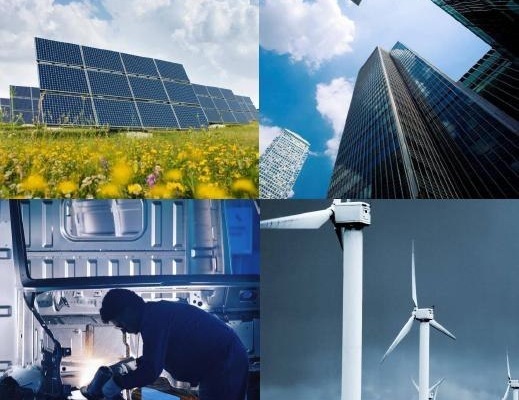NYSERDA Funding Leverages $11 Million in Additional Funds to Support New Technologies That Will Reduce Environmental Impact and Build Clean Energy Economy.
Albany, [WorldofRenewables.com]
The New York State Energy Research and Development Authority today announced the award of $11.3 million to help develop and commercialize 25 innovative renewable energy and energy storage projects. These next generation power technologies will advance progress toward a clean energy economy in New York.
The NYSERDA funding supports technological advances that could benefit a variety of applications including mass transit, farming, small- and large-scale electric generators, hand-held electric devices, and others. To finance the projects, NYSERDA will use $4 million of funds from proceeds from the Regional Greenhouse Gas cap and trade auctions, and $7 million of Systems Benefit Charge funds. These resources will leverage $11 million of private sector investment to bring total funding for these projects to $22 million.
“The projects announced today embody New York’s continued leadership in the clean energy economy and demonstrate the innovative approaches needed for us to achieve dramatic increases in our energy efficiency,” said Governor David Paterson. “The products that emerge from these initiatives will help create jobs and develop the tools needed to help us mitigate our impact on the environment for the next generation.
“The extraordinary quality of the proposals submitted for this program signals exciting progress in the development of New York’s clean energy economy,” said Francis J. Murray, president and CEO of NYSERDA. “The public private partnerships we are forming and strengthening with these funds will help create jobs, solidify New York’s standing as an energy leader, and develop the tools New York will need to achieve the ambitious energy-reduction goals set by Governor David Paterson.
The funds will support demonstration projects, new product development, and feasibility studies. Funded initiatives include seven photovoltaic and solar projects, seven electric storage projects, five wind power projects, two waste-heat reuse projects, and one project each in fuel cell and kinetic hydropower.
The twenty-five proposals were selected from 71 proposals submitted. Co-funding is required of each of the participants, with specific funding for each project to be determined in the coming months through final contract negotiations with each partner.
Demonstration Projects, $4.7 million NYSERDA funds
Electrical Storage:
- Ultralife Corp. (Newark, Wayne County) will demonstrate the benefits of co-locating a large lithium-ion battery storage system to modulate power sent to the grid with a 600kW wind turbine to be erected at SUNY Canton.
- Electrical Power WorX (Alfred) will demonstrate a trackside ultra-capacitor energy storage system that features high-capacity rapid charge and discharge without moving parts. This will support the New York City Transit system subway voltage and provide more efficient performance of the electrified rail systems.
- Sojitz Corporation of America (New York City) will demonstrate a stationary, high-capacity lithium-ion battery system to capture and release energy created by subway train regenerative braking. The field test for New York City Transit is expected to confirm results of a power-saving simulation that showed as much as a 50% reduction in power requirements from the grid.
Kinetic Hydro Energy:
- Verdant Power, Inc. (New York City) will conduct a pilot demonstration of three new Gen5 turbines and an improved channel-mounting system in the East River, off Roosevelt Island, Manhattan. This continuing-project phase focuses on lower-cost mounting and deployment methods, the reliability and longevity of the latest model turbines, as well as continued environmental monitoring. Having received global attention, this project stands as one of the most advanced kinetic hydro projects ever devised and is sited in the heart of a metropolitan market and subject to continuous extraordinary flow conditions
Biogas:
- EMG International, at N-Man Farm (Westtown, Orange County) will demonstrate a small (90-100 head) dairy farm anaerobic fluidized-bed digester that will convert manure to biogas for generating electricity
New Product Development, $4.1 million NYSERDA funds
Waste Heat to Electricity
- Ener-G-Rotors (Schenectady) is improving through redesign its 50kW prototype Rankine Cycle waste heat-electric generator with potential for many industrial applications, and thereby capturing and generating as much as 700,000 MWH of electricity per year, without any further combustion or emissions.
- Mohawk Innovative (Albany) is developing and demonstrating a scalable modular Rankine cycle turbo-generator line that will capture and convert waste heat to electricity.
Photovoltaics (PV):
- Graphene Devices, Ltd., (Williamsville) is developing the manufacture and application of grapheme films—a one-atom thick layer of carbon—to substitute for high-cost materials used in transparent conductive coatings for PV devices.
- Solar Sentry Corp., (Pittsford) is developing a wiring-string maximizer to improve performance and extend the life of PV installations by detecting and “working around” individual faulty modules so they do not impede surrounding module performance.
- Electrical Storage:
- The City University of New York is developing a rechargeable flow-assisted nickel-zinc battery for more cost-effective applications, including transportation and grid stabilization.
Fuel Cells:
- MTI Micro Fuel Cells, Inc. (Albany) will conduct a field trial of 200 hand-held, mobile fuel cell chargers for portable electronic devices.
Wind:
- AWS Truewind (Albany) is developing a Plant Analyst program for monitoring and optimizing wind plant equipment performance.
Feasibility Studies, $2.6 million NYSERDA funds
PV:
- Magnolia Solar (Albany) is working at the SUNY Albany Nanotech center to develop structured nanoparticle coating for thin-film PV cells that could double their performance and potentially halve their cost.
- Precision Electro Minerals Co. (Niagara Falls) is studying the establishment of a fused silica crucible manufacture for solar-grade silicon, used in making single-crystal PV cells, in New York State.
- University of Rochester is seeking to develop nanotechnology-enabled processing for inexpensive and more efficient thin-film silicon PV cells.
- RNY Solar, LLC. (Victor) is performing feasibility studies on novel solar-splitting concentrator modules that could improve solar collection by 100%.
Solar Thermal:
- SUNY Binghamton will work to develop new materials using nanofabrication techniques to create a solar-thermoelectric generator that uses the heat of solar radiation structure to make electricity.
Electrical Storage:
- Customized Energy (Endicott) is studying various electric storage devices to power refrigerated trailers while transporting produce from Albany to New York city via barge, displacing diesel-powered refrigeration to reduce petroleum use and air.
- Expansion Energy (Tarrytown) will work to develop an innovative energy storage system using ConEd steam to produce compressed liquid air for storage which can later be released for energy generation.
Fuel Cells and Electrical Storage fabrication:
- SUNY Albany Nanoscience, in cooperation with Cornell and Alfred University will perform R&D studies on nanoscale materials for a more standardized and cost-efficient fabrication of micro fuel cells and batteries.
Wind:
- Aero City (Claverack, Columbia County) is working on a small-scale wind turbine speed controller that would benefit the cost-effectiveness of residential or small commercial wind machines.
- Mechanical Solutions, Inc. (Albany) is studying non-intrusive equipment health-monitoring system for wind turbine generators.
- Rensselaer Polytechnic Institute, Troy will work to develop active vibration and flow control system using synthetic jets for wind turbine blades.
- Clarkson University (Potsdam) will work to develop a strain-monitoring tool for wind turbine generator rotors.
Biomass:
- Energy Research Co. (Staten Island) is studying use of laser monitoring when biomass is blended along with coal in generating stations to avoid ash-slagging problems associated with biomass.
Once contracted, most projects will be reporting on progress during this year and into 2011. All contracts feature milestone payments and many seek recoupment by NYSERDA if and when products developed with funding are sold on the open market. All benefit New York by being located here and having the potential to create new research, industry and jobs within the state.










